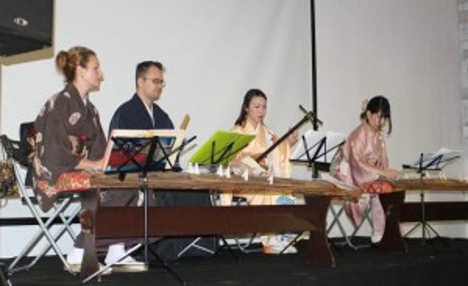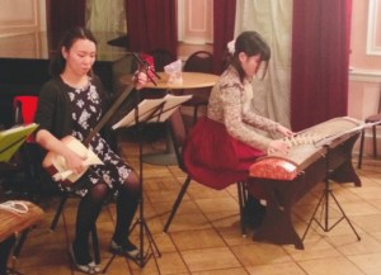Tsuchida Makiko, a TUFS student currently on an exchange program at Saint Petersburg State University, participated in an event to raise awareness about Japanese culture by playing a traditional Japanese instrument.
What follows is Ms. Tsuchida’s report.

On Sunday, November 11, 2018, Japanese Day in St. Petersburg, hosted by the Consulate General of Japan in St. Petersburg as part of the Japanese Year in Russia and the 15th Annual Japanese Autumn festivals, was held at the creative space Tokachi.
The event space included an origami classroom, a calligraphy classroom, a shogi and go corner, a Japanese conversation club, and booths for people to learn about tea-ceremony, kendo, and aikido; all in all the event bustled with people, both adults and children. On a specially erected stage, a taiko drum performance, an information session promoting Hokkaido held by local government officials, a demonstration of the wearing of kimono and yukata, a screening of a Japanese film, and of a Japanese anime, were observed with much acclaim by the Russian audience.
Together with Japanese students and a Russian teacher and some Russian friends of mine, we performed as an ensemble, using Japanese traditional instruments, and played Sakura Sakura and Itsumo Nandodemo. At TUFS, I am a member of the Japanese traditional instrument club called Hakugakai, where I play the shamisen. I brought my own instrument with me to St. Petersburg, so it was a great joy for me to have this opportunity to play it publicly.
Since coming to St. Petersburg, I have participated in Japanese traditional instrument sessions once a week at a Japanese Language center in the center of town. There are two Japanese people who participate: I myself play the shamisen, and a friend of mine plays the koto. In addition, we have Russians who accompany us on the shamisen and the shakuhachi, a kind of bamboo flute.

The Japanese Center frequently holds events related to introducing Japanese culture. On November 24, the center held an event entitled the Japanese Autumn, which featured recitations of Waka by Russian students of Japanese, demonstrations of Cat’s Cradle, a quiz, and other activities. At this event, like in the aforementioned Japanese Day in St. Petersburg, a performance of Japanese traditional instruments, namely the shamisen and the koto, was held.
I participated in this event as well, as an instrumentalist, and was amazed at how many people there are in Russia who hold an interest in Japanese culture. Some of them seemed to know more about Japanese culture than most Japanese would! Upon entering the venue, while holding my instrument, I was met with an assortment of comments, most notable were comments by Russians who said they had seen shamisen in photographs, but had never seen them with their own eyes before, nor heard them played. A number of people also commented on just how few shamisen players there are in St. Petersburg. Hearing these comments impressed upon me that though in the information age it may be easy to access information pertaining to one’s interests, it can still be difficult to see and to touch the object of one’s interests in real life. I certainly intend to look for more such events to participate in, and to use Japanese traditional instruments as a stepping stone to fostering an interest in Japanese culture on the part of Russians. I also look forward to more opportunities for cultural exchange.
Tokyo University of Foreign Studies, School of Language and Culture Studies, Russian department, 3rd year
On exchange in St. Petersburg
Tsuchida Makiko
